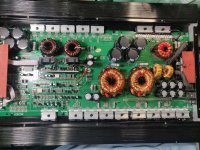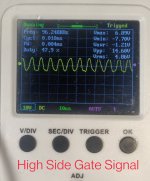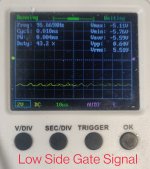Good Day. A friend bought a used, repaired amplifier and brought it to me to check out before use. It appears that the outputs were replaced and the low side drivers on the board were replaced also, but instead of MPSA56, they used MPSW56.
The problem I am seeing is that when powered up, the +rail jumps up to +77v and then settles at +74v, while the -rail settles at -60v without any RCAs plugged in. As soon as the RCAs are plugged in, the +rail jumps to +85v, and the -rail goes to -69v. The rail caps in this amplifier are 3300uf80v.
This is all being checked on the bench with a 12A power supply that outputs 13.7v with no load. The voltage measurements are taken with a voltmeter referenced to input GND. The scope shots are referenced to GND input with the probe set to 10x. Is there something I need to do to this amplifier for safe operation?
The problem I am seeing is that when powered up, the +rail jumps up to +77v and then settles at +74v, while the -rail settles at -60v without any RCAs plugged in. As soon as the RCAs are plugged in, the +rail jumps to +85v, and the -rail goes to -69v. The rail caps in this amplifier are 3300uf80v.
This is all being checked on the bench with a 12A power supply that outputs 13.7v with no load. The voltage measurements are taken with a voltmeter referenced to input GND. The scope shots are referenced to GND input with the probe set to 10x. Is there something I need to do to this amplifier for safe operation?
Attachments
The transistor substitute is basically the same although obsolete.
Did you monitor the 13.7volt supply.
Without a schematic, we basically have no real idea but educated guesses.
Did you monitor the 13.7volt supply.
Without a schematic, we basically have no real idea but educated guesses.
So, I wired it up in a vehicle. With the vehicle engine on supplying 14v, the +rail is sitting at +80v and the -rail is at -66v without RCAs connected. If I plug in the RCAs, the +rail rises to +91v and the -rail goes to -75v. The rail caps in this amp are 80v 3300uf. Won't these rail caps pop if used in this condition? Isn't there something needing attention in the rail voltage regulation or am I not measuring correctly? If I use the -SPKR terminal for reference, the voltages are even higher.
This is typically due to river problems.
Look at the voltage swing from the transformer on the input of the rectifiers and the DCV on the output legs of the rectifiers. When the rail voltage goes high, does the output of the rectifier go higher or lower than the swing from the transformer?
Look at the voltage swing from the transformer on the input of the rectifiers and the DCV on the output legs of the rectifiers. When the rail voltage goes high, does the output of the rectifier go higher or lower than the swing from the transformer?
I will check with the scope later this evening, but just asking, what components are usually changed to repair this issue? The low side drivers (Q124 Q125 equivalents) were already replaced in this amplifier.
Is the color different between Q124 and Q125?
The voltage is typically excessive on the rail where the defective drive circuit is driving the outputs. The most common is when Q124/5 are not working as they should and the negative rail voltage goes well over the rated voltage of the rail caps, blowing the negative rail caps.
If you're seeing the high positive rail, it's likely that the other half of the driver circuit is defective.
The voltage is typically excessive on the rail where the defective drive circuit is driving the outputs. The most common is when Q124/5 are not working as they should and the negative rail voltage goes well over the rated voltage of the rail caps, blowing the negative rail caps.
If you're seeing the high positive rail, it's likely that the other half of the driver circuit is defective.
- Home
- General Interest
- Car Audio
- Uneven High Rail Voltage




